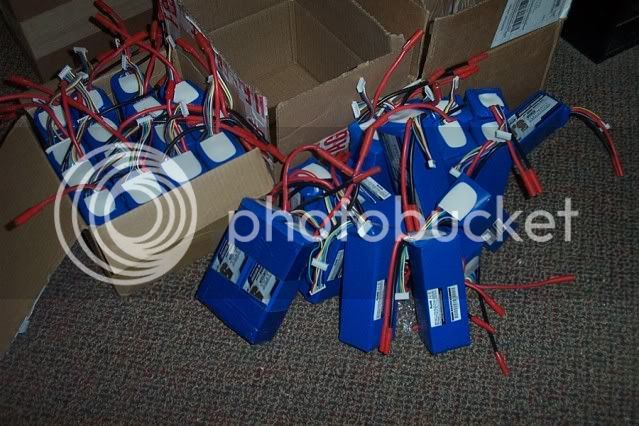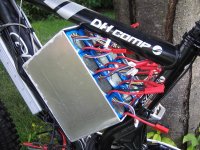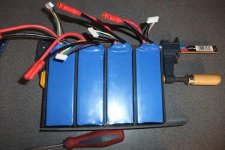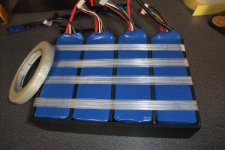recumpence
1 GW
I know, I know, many people will think "Oh my gosh, another Lipo thread? I thought this has all been hashed out!" 
The reason for this thread (the mods can move it to a different section if they deem necessary) is to post our personal experiences with Lipo chemistry. I felt the need to start this thread based on some misconceptions floating around lately. So, with that being said, here are my personal findings..........
I have been running Lipo in my RC models since the beginning. I remember the first pack I had was rated at 2C. That pack lasted hundreds of cycles before it died. When it died, it reduced its C rating (it had less power and more voltage drop under load) and its total AH capacity. However, it died from pulling too many Cs through it. It ran totally perfect until I went with a larger motor in the heli it was in. Next I went to 10C packs. These lasted a very long time (hundreds of recharges)-(this is a long time in hard RC use). These packs finally went bad from overdischarging them. I was taking them down to 10% state of charge. :|
After that, I met Brian from Tanic packs. He and I worked out a deal for a huge number of cells. These were all 10C as well. I made many packs and had mixed success. These were still very old technology packs (maybe 7 years ago?) that sat for a long time before use.
At this point, I began getting a bad feeling about Lipo, though I still ran them because they were the lightest option available. Then disaster struck......... I had a tiny 2S-320 mah pack explode in my house when my charger failed. My wife put the fire out and I thought that was it for me with Lipo. But, I stuck with it and was determined to figure out what went wrong and how to fix it.
A number of people told me the new generation cells and chargers are light years better than the old crap I was running. So, I upgraded my charger and my packs and BINGO, they were right! All charging issues went away. Also, my packs lasted nearly forever. In fact, I was selling packs to friends when new technology became available because they were lasting so long.
Fast forward to 3 years ago when I built my recumbent. That pack is still old technology cells (10C cells that sat in storage for a couple years). I have over 1,100 miles on it with no signs of degradation.
Here is the state of Lipo right now.........
#1 The cells are way better than they were even two years ago.
#2 The chargers are light years better as well.
#3 If used correctly, Lipos last a very long time.
#4 The safety issues with Lipo are roughly the same as other chemistries these days.
What is correct use? That is in the Lipo use thread. But, I will put it this way------ Stay under the C limit and keep over 25% state of charge in the pack and it will last 1,000 recharges before any degradation is noticed. To illustrate that point, I have a lipo (V1 5C pack) in my RC heli transmitter from 5 years ago that is still running like new. Why? Because it is never drained below 25% and is never run past its C limit.
All chemistries have their degradation issues and their safety issues. At this point, Lipo is on-par with pretty much all other chemistries in regards to safety, number of recharge cycles, and overall ease of use (if proper charging is maintained). Heck, I have had Nicad packs burn up, I have had Alcaline cells burn up, and I have seen A123 packs burn vehicles to the ground. They all need to be treated with respect. In fact, Lipo packs are actually more stable than others in regard to staying in balance. If they are kept above 20% state of charge, I have NEVER had one (and I have run over 100 packs) go out of ballance beyond .1 volts.
That is my take on it..........
I know others on this forum have had bad experiences with Lipo. But, I would hazard a guess that something caused the problems wether it was overdischarging, or some other outside force at work. Of course, anything can happen. I have also gotten a bad pack from Hobby King. So, there are various factors involved.
Lastly, it seems as though Lipo problems are posted readily on this forum, while problems with other chemistries are not mentioned. But, I hear about them through PMs and emails. There seems to be an aversion to mentioning problems with the "Safe" chemistries. But, I have seen my share of problems with A123, Headway, Ping (lots of Ping problems) and others and I have had my own problems with various chemistries, including Lipo.
Matt
The reason for this thread (the mods can move it to a different section if they deem necessary) is to post our personal experiences with Lipo chemistry. I felt the need to start this thread based on some misconceptions floating around lately. So, with that being said, here are my personal findings..........
I have been running Lipo in my RC models since the beginning. I remember the first pack I had was rated at 2C. That pack lasted hundreds of cycles before it died. When it died, it reduced its C rating (it had less power and more voltage drop under load) and its total AH capacity. However, it died from pulling too many Cs through it. It ran totally perfect until I went with a larger motor in the heli it was in. Next I went to 10C packs. These lasted a very long time (hundreds of recharges)-(this is a long time in hard RC use). These packs finally went bad from overdischarging them. I was taking them down to 10% state of charge. :|
After that, I met Brian from Tanic packs. He and I worked out a deal for a huge number of cells. These were all 10C as well. I made many packs and had mixed success. These were still very old technology packs (maybe 7 years ago?) that sat for a long time before use.
At this point, I began getting a bad feeling about Lipo, though I still ran them because they were the lightest option available. Then disaster struck......... I had a tiny 2S-320 mah pack explode in my house when my charger failed. My wife put the fire out and I thought that was it for me with Lipo. But, I stuck with it and was determined to figure out what went wrong and how to fix it.
A number of people told me the new generation cells and chargers are light years better than the old crap I was running. So, I upgraded my charger and my packs and BINGO, they were right! All charging issues went away. Also, my packs lasted nearly forever. In fact, I was selling packs to friends when new technology became available because they were lasting so long.
Fast forward to 3 years ago when I built my recumbent. That pack is still old technology cells (10C cells that sat in storage for a couple years). I have over 1,100 miles on it with no signs of degradation.
Here is the state of Lipo right now.........
#1 The cells are way better than they were even two years ago.
#2 The chargers are light years better as well.
#3 If used correctly, Lipos last a very long time.
#4 The safety issues with Lipo are roughly the same as other chemistries these days.
What is correct use? That is in the Lipo use thread. But, I will put it this way------ Stay under the C limit and keep over 25% state of charge in the pack and it will last 1,000 recharges before any degradation is noticed. To illustrate that point, I have a lipo (V1 5C pack) in my RC heli transmitter from 5 years ago that is still running like new. Why? Because it is never drained below 25% and is never run past its C limit.
All chemistries have their degradation issues and their safety issues. At this point, Lipo is on-par with pretty much all other chemistries in regards to safety, number of recharge cycles, and overall ease of use (if proper charging is maintained). Heck, I have had Nicad packs burn up, I have had Alcaline cells burn up, and I have seen A123 packs burn vehicles to the ground. They all need to be treated with respect. In fact, Lipo packs are actually more stable than others in regard to staying in balance. If they are kept above 20% state of charge, I have NEVER had one (and I have run over 100 packs) go out of ballance beyond .1 volts.
That is my take on it..........
I know others on this forum have had bad experiences with Lipo. But, I would hazard a guess that something caused the problems wether it was overdischarging, or some other outside force at work. Of course, anything can happen. I have also gotten a bad pack from Hobby King. So, there are various factors involved.
Lastly, it seems as though Lipo problems are posted readily on this forum, while problems with other chemistries are not mentioned. But, I hear about them through PMs and emails. There seems to be an aversion to mentioning problems with the "Safe" chemistries. But, I have seen my share of problems with A123, Headway, Ping (lots of Ping problems) and others and I have had my own problems with various chemistries, including Lipo.
Matt






